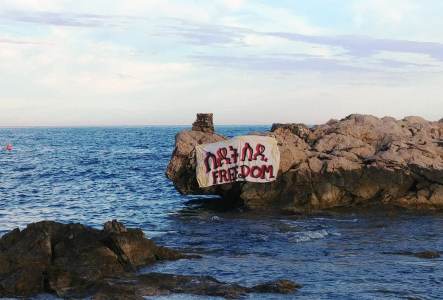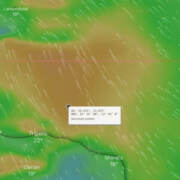Repression and Resistance in Sicily and Ventimiglia
Article first published on July 30, 2021
Borderline Sicilia monitors the situation at the end of maritime border crossings from North Africa to Europe. The monitoring in Sicily provides insight into how fiercely Europe “defends” its external borders against people in need of protection, who are abandoned to drown in the Mediterranean in the name of “national security.”
But we often forget that for those who survive the perilous crossing, the Mediterranean is not the last border to be crossed. The “European Fortress” has not only implemented measures of closure against those on the outside but has also made the movement of undocumented people between the European states illegal and criminalized.
Pursuant to the Dublin Treaty, those who arrive have no option of seeking asylum in a different country from the one they entered; yet the will and the hopes of crossing internal European borders and of exercising the freedom of mobility, which is or should be a right of all, still persists. Although there are so-called “relocation programs” that can enable people to cross from their country of first entry to another state of the E.U., their selection processes are based on inscrutable criteria and without the opportunity for people to plead their own cases (Ad Hoc Relocation). Everyone, regardless of their nationality, ought to have the right to decide for themselves how, where, and when to move.
In Sicily, we often hear about people who arrived to or just stopped on the island before reaching the north of Italy, France or Germany. Each time we are relieved that another step of the journey to the respective destination has been made, and that freedom of movement has not (yet) been completely eradicated. But what does this trip really mean for people? What are the obstacles on their path? One thing is certain: unlike for those who hold a European passport, the undocumented can’t simply buy a ticket and get on the next train, bus, or plane.
Instead, it is more likely – if, say, France should be their destination – that the route of this trip passes through Ventimiglia, a city in the north of Italy on the border with France. Police forces, who allow the passage of cars at the border with Italian or French plates and who don’t look twice at white passengers on regional trains, behave in a completely different mode with those non-white Caucasian travelers. Ventimiglia is a porous border, and many still manage to pass across by walking along the seafront or by train, but this is a lottery with the risk of being deported and of being forced to spend hours in containers at the border, sustaining physical and verbal abuse by the police.
In the attempt to avoid this risk, many undocumented people choose to take the mountain border route by foot at night, traversing a heavily wooded valley. But at night the signs on the trees and rocks are difficult to see, and it is easy to lose one’s way. It is not surprising that this most frequently taken route is called the “path of death.” The alternative option on the highway is no less dangerous by foot at night. In either case, just as much along the mountain paths, there is the risk of being arrested by police and detained in a container, in a restricted space without even a bathroom for the night. Still, there is hope that this situation will improve soon.
Borders always have two sides: the point of departure and the point of arrival. Contrary to Sicily, Ventimiglia is a point of departure from within Europe. This being so, we have the ability to observe the conditions through which people attempt to continue their journey, while what happens in non-European places of departure we know only through the eyes of those who successfully arrive.
The ravines found below a point of the highway in Ventimiglia serve as “temporary lodging” and a point of departure for the border crossing, and every day volunteers bring food and clothing, as well as a generator and sockets to charge cell phones. This place also frequently turns into an information point where people in transit can find activists and operators to answer their questions. This support was banned for a long time and had to be conducted in secrecy. Now it is tolerated, though with police presence.
The people encountered here are mostly (heterosexual) men, because women and LGBTQ-people rarely go under the bridge or cross the border – and when they do, they are usually accompanied by a man. Where you would find these individuals, who certainly exist but are not often seen, is unclear. What is certain is that the dangers involved for these people are multiplied due solely to their sexual identity. Another group missing at this border is Tunisians.
Recently, due to the deterioration of the situation in the North African countries, an ever-growing number of people have been taking the route across the Mediterranean. But because of the bilateral accords between Tunisia and Italy, almost every person of Tunisian nationality is deported or rejected immediately following their quarantine period after arriving in Sicily. Thus, because of their nationality they have practically no chance of building a life in Europe.
In mid-July there was a Transborder Camp in Ventimiglia to promote the abolition of borders and to draw attention to discriminatory European and Italian-French policies implemented by local institutions. The efforts on behalf of activists have clearly shown that this work has not been well-received. An attempt was made to set up a camp beneath a point of the highway, which would have been visible to passers-by, but it was immediately evacuated and removed to outside the city. Although a protest in the city was tolerated, the following day the police intervened with a peaceful protest right on the border.
At first, leaflets were passed out to car and motorcycle drivers crossing the border, which explained how the right to cross freely is unjustly afforded only to some. Then the border was closed for a few minutes. Nonetheless, it can be supposed that our message reached the drivers: the borders are not (yet) open and passable to all.
Depending on the border – maritime or terrestrial, between countries outside the EU or other member states, visible as in Ventimiglia or invisible as in Sicily – the EU looks for means of limiting the freedom of movement for certain people. For people who are forced to move because of the politics of European states, that have created a hierarchy of power for centuries and continue to do so. In the past it was the era of colonialism, today it is capitalist exploitation, including the exportation of arms to areas in crisis and economic practices that change and damage our climate.
Still, the “European Fortress” and its member states maintain Frontex, the so-called “border protection agency” which regularly commits human rights violations and finances Libya to stop refugees from crossing the border into Europe. Likewise, it keeps closed its internal borders against those who managed to survive the dangerous crossing of the Mediterranean.
These necropolitics that prevent freedom of movement must end, at every border.
All borders are constructed and can therefore be deconstructed.
Josephine Fahr
Borderline Sicilia/borderline-europe
Translated from the Italian by Olivia Taibi



